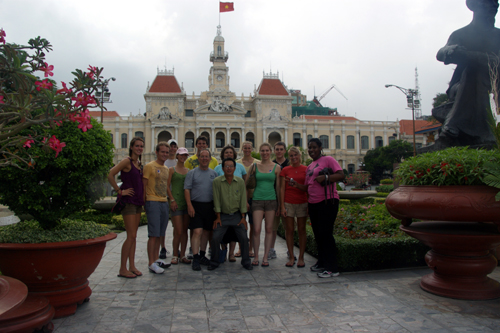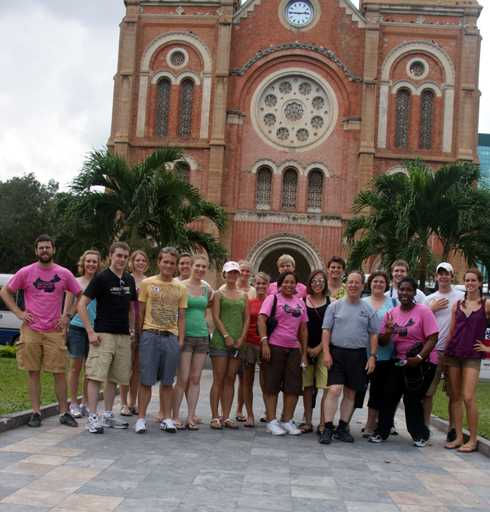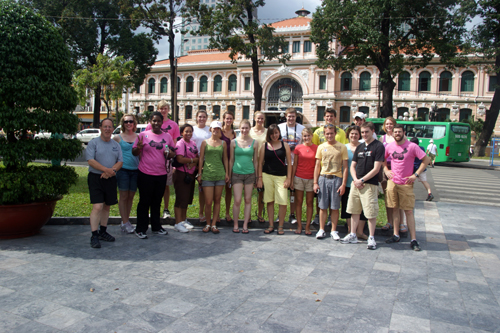Before I let Saigons be Saigons (again—see my January post for the first impressions), there are two items that were in the Singapore paper this morning that sum up well what I’ve mentioned about Singapore:
1) The strict controls by the government (which have led to close business-government cooperation): A minimart had its license to sell cigarettes revoked for six months because the store had been caught twice selling cigarettes to minors. It is a well-run, usually benevolent, one-party dominant state.
2) I’ve mentioned the twin pillars of trade and tourism as providing the means for a city-state of 3.2 million to become one of the most prosperous nations of the world. Tourism was down 13% March this year versus March last year; Singapore has a special promotion that anyone flying Singapore airlines (and after the 2-hour trip here on Singapore Air, I think everyone in our party wanted to fly Singapore Air across the Pacific, instead of United) who lands in Singapore can stay overnight in one of six very nice hotels for $1, with some fringe benefits thrown in. As I said, I’m astonished that the government of the nation has allowed gambling, but that is one of the major attractions, especially for Chinese in the region.
As for our 36-hour R&R in Saigon (we got in around 3 this afternoon and will be leaving our hotel after 36 hours here), the city means different things to our students than I’m sure it does to my generation. Those of us who came of age in the 60s have memories of Saigon whether we served in Vietnam or did not. Over 50,000 Americans died in what the Vietnamese, who have a history of being invaded and then defeating the invaders, call “the American War.”
When we got in, we were whisked to AA corporation, where Chad Ovel, whom I met in January, had agreed to talk to this class. He’s a Carleton grad, major in economics and international relations, who as a student did a semester in Beijing, and got infected (as I have) with Asia. A week after graduation, he packed his bags for Asia, and hasn’t been back to live in America since, about 15 years in total. Along the way, he’s worked for the World Wildlife Federation (the panda guys), acquired an MBA from the University of Chicago (which has campuses in Singapore as well as Chicago and I believe London), and now is taking a $20 million niche furniture company (custom-made for rich people and corporations—the next time you’re at the Intercontinental in New York) to the $200 million level and turning it green as well. His office had a meeting going on, so he found a café on the Saigon River in the expat neighborhood that I’m sure we were one of the few non-locals (either expat or local Vietnamese) to grace. He talked and answered questions for about an hour, and a number of students commented that they really thought it was as good a visit as I’d promised—and I promised a great one, with discussions that paralleled Friedman’s Hot, Flat, and Crowded book. He earned high marks from the students, and not just because he bought everyone two rounds of drinks!
Today we spent on the history of Saigon, partly its French period (abut 100 years, ending in 1954, when the French left Indochine), and partly the American War (as they call it) period, from 1954 in effect until 1975, when the famous North Vietnamese tanks smashed through the presidential palace gate and, on April 30, “liberated” South Vietnam, renaming the presidential palace the reunification palace instead.
There’s a lot from both periods here. For example, as I’ve mentioned, the baguettes. In the morning, students who wanted to join me got up and went to a street stand, which was selling a breakfast sandwich that could only have been inspired by the French—a baguette with fillings that made the hotel breakfast (which does serve lots of fruit and juices) seem tame.
The Cu Chi tunnels, our first destination, spans both periods, though the Vietnamese developed the 150-mile tunnel system mostly after 1954, when it became the terminus of the Ho Chi Minh trail. At one time, over 100,000 Viet Cong lived, fought, and died in the tunnels, which were three stories high (or maybe I should say low, since they were below ground, in three different levels. The defenders took about 80% casualties, but caused havoc in Saigon and the local U.S. Air Force base nearby. One partial tunnel is opened, expanded wide for tourists, and one could crawl through it and see how people lived for up to 20 years. The area also has ghastly reminders (if one were needed) of the havoc bombing played in the American War, huge craters being one of the distinctive features of the area. It shows the lengths (and depths) to which the Vietnamese went to reunify a country that the U.S. and other powers had stated in 1954 would be reunited peacefully. The Vietnamese (and this wasn’t on display) came very close to seeking a peace treaty (rather than imposing one) until the 1968 Tet offensive (I have clear snapshots in my mind of the sack of the Citadel in Hue by Vietcong troops, and the bitter fighting at the American Embassy in Saigon) created sufficient war weariness in the United States that we looked for ways to say, “We won,” and get out saving some face.
An even starker message came at the War Remnants Museum, which promised to provide us with historical accuracy in the history of the American war, and it’s depiction of the suffering the war caused, and the desperate means we used to defoliate and defeat (Agent Orange being one item) that made me hearken back to the response I’ve had when viewing the Holocaust museums in Europe. Over 3,000,000 Vietnamese died in the American War, mostly civilians. Nonetheless, the Vietnamese have put the war behind them, and I wish we would, too. That was over 35 years ago, aeons in historical time. Probably 70% of the Vietnamese, like my students, are too young to remember the war.
At least the experience is less macabre than I remember it in 1995, when we walked through the jungle at Cu Chi and periodically a sign would pop up telling you that you’d been killed by a sniper or walked on a land mine, or landed in one of the bamboo traps that mauled and maimed.
The other places we visited reflect mostly the French colonial period, in the shape of the remnant buildings (there some American buildings; we stayed at the Rex in 2001, the home of wartime journalists, and a decaying but genteel hotel; it’s now the most expensive hotel in town). We took pictures in front of City Hall, the Notre Dame Cathedral, and the Post Office (I’ll try to post them later tonight), all of which, plus the Opera House, might well be in Paris. In fact, Saigon was one of several cities in Asia that earned the nickname, “Paris of the East.” I got to a museum I’d never been to before, a city museum, and found our guide’s warning—the building is elegant, the contents are not—right on target, but it enabled me to hide from a thunderstorm that temporarily cooled the city, but heightened the humidity. If possible.
Tonight, we’re taking a rickshaw ride around the area on our way to see the Hanoi-based water puppet show, one of the highlights of visiting Hanoi, and hence, a treat here too. Carrie and I have reservations at what we’ve been told is a really nice Vietnamese restaurant (the food is outstanding!), and two students are joining us. The rest decided to spend their R&R in Saigon as young Americans (and young Aussies, and young….) are wont to do. We have a 4 a.m. departure time from the hotel, so it could be an interesting plane ride to Hong Kong.
Good night, or should I say, “bon soir.”




